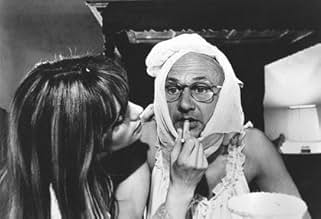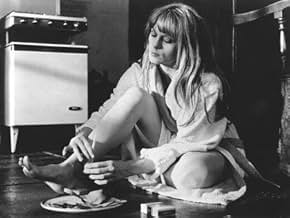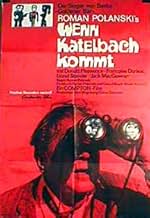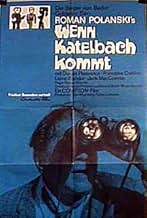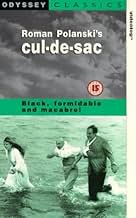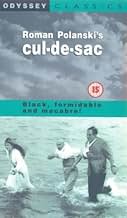CALIFICACIÓN DE IMDb
7.0/10
15 k
TU CALIFICACIÓN
En busca de ayuda, dos gánsteres heridos que se han dado a la fuga se refugian en la casa de un hombre débil y su mujer. Pero nada es lo que parece a punta de pistola.En busca de ayuda, dos gánsteres heridos que se han dado a la fuga se refugian en la casa de un hombre débil y su mujer. Pero nada es lo que parece a punta de pistola.En busca de ayuda, dos gánsteres heridos que se han dado a la fuga se refugian en la casa de un hombre débil y su mujer. Pero nada es lo que parece a punta de pistola.
- Dirección
- Guionistas
- Elenco
- Nominada a1 premio BAFTA
- 1 premio ganado y 1 nominación en total
Jacqueline Bisset
- Jacqueline
- (as Jackie Bisset)
- Dirección
- Guionistas
- Todo el elenco y el equipo
- Producción, taquilla y más en IMDbPro
Opiniones destacadas
After their car becomes stuck on a causeway, two gangsters named Dickey and Albie find themselves stranded on the remote island of Lindisfarne. There, they take refuge in a castle owned by an eccentric couple, the mentally unbalanced George and his promiscuous and beautiful wife Teresa. The hoods proceed to hold George and Teresa hostage, until their boss Katelbach can send them some transportation off the rock. However, matters become complicated by the arrival of a group of George's friends, one of whom Teresa has an affair with. So begins 'Cul-de-sac,' a tale of madness, sexual frustration and pitch-black comedy that could only have come from the mind of Roman Polanski.
Original, abstract and frequently funny, Polanski's 'Cul-de-sac' is a fascinating, captivating movie that will delight any fan of the dark and strange. Much like his earlier 'Repulsion,' the film launches the viewer into a weird world populated by odd folk struggling with their desires and how to interact with the people around them. The characters engage in a power struggle throughout the film, with manipulation and thuggery being the prime weapons at their disposal. While the hoodlums take George and Teresa hostage, it is also Teresa who makes George a hostage of her lust, and it is she who does the most damage to his psyche.
It is a film that will likely spark differing opinions as to what the meaning of it all is. Some cinema-goers enjoy the guesswork, though others find abstractions infuriating; and 'Cul-de-sac' is not for the impatient or the shunners of philosophy. It's an intriguing, dark thriller that also happens to be one of Polanski's funniest outings, as he injects the narrative with much off-beat humor and sharp, banterous dialogue. The film still features his trademark examinations of paranoia, isolation and social unease; though told in a slightly lighter fashion than one accustomed to Polanski would expect (which, for this viewer anyway, comes as a boon to the proceedings).
'Cul-de-sac' is a visually enthralling flick, featuring arresting cinematography from Gilbert Taylor, who lent his talents to the previous 'Repulsion,' and would go on to work with Polanski once more on 'MacBeth.' Their collaborations made for undeniably artistic and powerful visuals that intrigue and impress, both in creative and technical terms. 'Cul-de-sac' boasts some incredible cinematography, from intense tracking shots to the masterful manipulation of light and shadows; Taylor's distinct and evocative work under Polanski's firm direction is unforgettable.
Alastair McIntyre was a frequent collaborator of Polanski's, and his editing for 'Cul-de-sac' is swift and smart. Reportedly, the two men toiled very closely together in the editing suite, developing over the years an intuitive and fruitful working relationship build on mutual respect and admiration. Looking at the remarkably tight, streamlined final cut of 'Cul-de-sac;' it's easy to see why Polanski utilized McIntyre on six films- his work is nigh on flawless.
Also of note is the score from Krzysztof Komeda, which is jazzy and strangely haunting; like elevator music from Dante's second circle of hell. His melodies fit perfectly the images of the film, as odd and as unsettling as some of them may be. Additionally, Bridget Sellers' rich costume design and George Lack's detailed set decoration and art direction lends the film additional impact and depth to the locales and characters.
'Cul-de-sac' stars Donald Pleasence as George, Françoise Dorléac as Teresa and Lionel Stander as Dickey, with the three of them turning in strong performances that are highlights in each of their filmographies. Pleasence is terrific as the unhinged, deeply neurotic George, imbuing him with an almost childlike quality which makes the character all the more interesting and odd. Though sometimes in films Pleasence had a tendency to go a little over-the-top, here he remains grounded, despite the weirdness of the role; doing consummate work that is hard to forget.
Dorléac- who tragically died before making it as big internationally as her sister Catherine Deneuve- is nothing short of a sensation as Teresa, giving a performance of wit, intelligence and depth that is a real treat to watch. As wily and as seductive as a panther in the night, Dorléac is not afraid to make Teresa unlikable, though she remains charismatic throughout. From her all too short career in film, Dorléac's assured performance in 'Cul-de-sac' is her greatest and most compelling.
Finally, Lionel Stander is brilliant as Dickey, the humorous hoodlum who takes hostage and tries to manipulate George and Teresa. Stander was a talented actor whose screen presence- like Ernest Borgnine- was such that you'd warm to him no matter what he did, evil or nay. With his crooked grin and gravelly voice, he leaves an indelible impression on the viewer; making Dickey a character that is most memorable. The supporting cast all perform admirably too, with a young Jacqueline Bisset and Jack MacGowran impressing the most.
Roman Polanski's 'Cul-de-sac' is a powerful and off-beat thriller that has a lot to offer viewers. Featuring an atmospheric Krzysztof Komeda score, stunning visuals from Gilbert Taylor and a cast performing at the top of their games; there is very little not to praise about the movie. If you enjoy films of abstractions and you have not seen it before, it is advisable that you do so now; as 'Cul-de-sac' is a weird, wild and wonderful movie that is not to be missed.
Original, abstract and frequently funny, Polanski's 'Cul-de-sac' is a fascinating, captivating movie that will delight any fan of the dark and strange. Much like his earlier 'Repulsion,' the film launches the viewer into a weird world populated by odd folk struggling with their desires and how to interact with the people around them. The characters engage in a power struggle throughout the film, with manipulation and thuggery being the prime weapons at their disposal. While the hoodlums take George and Teresa hostage, it is also Teresa who makes George a hostage of her lust, and it is she who does the most damage to his psyche.
It is a film that will likely spark differing opinions as to what the meaning of it all is. Some cinema-goers enjoy the guesswork, though others find abstractions infuriating; and 'Cul-de-sac' is not for the impatient or the shunners of philosophy. It's an intriguing, dark thriller that also happens to be one of Polanski's funniest outings, as he injects the narrative with much off-beat humor and sharp, banterous dialogue. The film still features his trademark examinations of paranoia, isolation and social unease; though told in a slightly lighter fashion than one accustomed to Polanski would expect (which, for this viewer anyway, comes as a boon to the proceedings).
'Cul-de-sac' is a visually enthralling flick, featuring arresting cinematography from Gilbert Taylor, who lent his talents to the previous 'Repulsion,' and would go on to work with Polanski once more on 'MacBeth.' Their collaborations made for undeniably artistic and powerful visuals that intrigue and impress, both in creative and technical terms. 'Cul-de-sac' boasts some incredible cinematography, from intense tracking shots to the masterful manipulation of light and shadows; Taylor's distinct and evocative work under Polanski's firm direction is unforgettable.
Alastair McIntyre was a frequent collaborator of Polanski's, and his editing for 'Cul-de-sac' is swift and smart. Reportedly, the two men toiled very closely together in the editing suite, developing over the years an intuitive and fruitful working relationship build on mutual respect and admiration. Looking at the remarkably tight, streamlined final cut of 'Cul-de-sac;' it's easy to see why Polanski utilized McIntyre on six films- his work is nigh on flawless.
Also of note is the score from Krzysztof Komeda, which is jazzy and strangely haunting; like elevator music from Dante's second circle of hell. His melodies fit perfectly the images of the film, as odd and as unsettling as some of them may be. Additionally, Bridget Sellers' rich costume design and George Lack's detailed set decoration and art direction lends the film additional impact and depth to the locales and characters.
'Cul-de-sac' stars Donald Pleasence as George, Françoise Dorléac as Teresa and Lionel Stander as Dickey, with the three of them turning in strong performances that are highlights in each of their filmographies. Pleasence is terrific as the unhinged, deeply neurotic George, imbuing him with an almost childlike quality which makes the character all the more interesting and odd. Though sometimes in films Pleasence had a tendency to go a little over-the-top, here he remains grounded, despite the weirdness of the role; doing consummate work that is hard to forget.
Dorléac- who tragically died before making it as big internationally as her sister Catherine Deneuve- is nothing short of a sensation as Teresa, giving a performance of wit, intelligence and depth that is a real treat to watch. As wily and as seductive as a panther in the night, Dorléac is not afraid to make Teresa unlikable, though she remains charismatic throughout. From her all too short career in film, Dorléac's assured performance in 'Cul-de-sac' is her greatest and most compelling.
Finally, Lionel Stander is brilliant as Dickey, the humorous hoodlum who takes hostage and tries to manipulate George and Teresa. Stander was a talented actor whose screen presence- like Ernest Borgnine- was such that you'd warm to him no matter what he did, evil or nay. With his crooked grin and gravelly voice, he leaves an indelible impression on the viewer; making Dickey a character that is most memorable. The supporting cast all perform admirably too, with a young Jacqueline Bisset and Jack MacGowran impressing the most.
Roman Polanski's 'Cul-de-sac' is a powerful and off-beat thriller that has a lot to offer viewers. Featuring an atmospheric Krzysztof Komeda score, stunning visuals from Gilbert Taylor and a cast performing at the top of their games; there is very little not to praise about the movie. If you enjoy films of abstractions and you have not seen it before, it is advisable that you do so now; as 'Cul-de-sac' is a weird, wild and wonderful movie that is not to be missed.
As 'Cul-de-sac' was Polanski's first movie after his brilliant psychological thriller 'Repulsion' it can't help but be a slight disappointment. Even so, I thought it was an interesting movie and I found it to be much more enjoyable than his next one the totally unfunny spoof 'The Fearless Vampire Killers'. 'Cul-de-sac' is quite difficult to catergorise. In some ways it reminded me of Pinter's 'The Birthday Party' (filmed much later than this but originally staged in the late 1950s), in others of Jack Hill's cult favourite 'Spider Baby' (made earlier but not really released until afterwards), and you could almost see it as prefiguring 'Performance' (old school gangsters meet the new world of the swinging 1960s). But really it quite an odd and unique black comedy. It may not be 100% successful, and it does have a few dull spots, but overall it's worth tracking down if you want to see something different. The main reason it succeeds for me is the unusual location of Lindisfarne, England (which I have visited), and the performances of Donald Pleasence, Francoise Dorleac and Lionel Stander. Pleasence was one of Britain's most underrated character actors, the beautiful and doomed Dorleac had appeared alongside Jean-Paul Belmondo in the entertaining thriller 'That Man From Rio', and Standish, who later appeared in movies by Leone and Spielberg, is best remembered as Max, the craggy manservant on the popular 1980s TV show 'Hart To Hart'. All three are excellent in this movie, and their interaction make it fascinating viewing. The supporting cast also includes Jack MacGowran ('The Exorcist') and an early appearance by 1970s sex symbol Jacqueline Bisset. 'Cul-de-sac' is without a doubt Polanski's most underrated movie, and fans of the unusual and the off beat will enjoy it very much. A DVD with a commentary from Polanski would would be wonderful. Any chance?
Captivatingly bizarre movie. Dickie and Albie, both injured and on-the-run following a failed heist, stumble upon effeminate George and promiscuous Teresa's secluded castle on the shore. Lionel Stander as the menacingly uncouth thug Dickie is the standout in the cast as he takes over the household while waiting for the gang boss to come and get him and his partner. Donald Pleasence and Franciose Dorleac as the invaded couple were also excellent as they deal with not only the crooks but an unwelcome family visit. Not for everybody but if you're in the mood for something unusual from the 60s or just wanting to view an example of early Polaski .
Cul-de-sac is a very beautiful black and white movie. It belongs to the lightweight category. The story is weird in an entertaining way, often amusing and sad at once. If the director tried to be willingly shallow, he was very successful. And I do not mean that ironically but say it with awe.
The place is Holy Island, on the east coast of Northern England. It actually gets cut off with the tide. Polanski makes very good use of the location and was very lucky with the casting. All characters are rather detestable in a detached sort of way. Donald Pleasance gives the performance of his life as the emasculated, utterly humiliated owner of the castle on the island. The other two main characters are the brisk yet elf like Françoise Dorléac and Lionel Stander as a gruff, brutal gangster. There is a very strange, truly unique chemistry between Dorléac and Stander. Dorléac does something to Stander. «We call dees a bicycle», she says gleefully with her funny accent, and it nearly knocks me off my chair every time I see that well filmed, suspenseful scene. I wont tell you what «de bicycle» is it may need parental guidance to watch it but does not belong to the restrictable area. Cul-de-sac has a very memorable musical score.
The place is Holy Island, on the east coast of Northern England. It actually gets cut off with the tide. Polanski makes very good use of the location and was very lucky with the casting. All characters are rather detestable in a detached sort of way. Donald Pleasance gives the performance of his life as the emasculated, utterly humiliated owner of the castle on the island. The other two main characters are the brisk yet elf like Françoise Dorléac and Lionel Stander as a gruff, brutal gangster. There is a very strange, truly unique chemistry between Dorléac and Stander. Dorléac does something to Stander. «We call dees a bicycle», she says gleefully with her funny accent, and it nearly knocks me off my chair every time I see that well filmed, suspenseful scene. I wont tell you what «de bicycle» is it may need parental guidance to watch it but does not belong to the restrictable area. Cul-de-sac has a very memorable musical score.
A wounded criminal and his dying partner take up refuge at a beachfront villa, which (not surprisingly) makes the owners less than thrilled.
I watched this as part of my quest to see all of Polanski's films in order. After two psychological films, he has switched to comedy... and I am not entirely sure I get it. Visually, this film is quite stunning and it has some good camera work (including one of the longest continuous sequences in cinematic history at the time of release at 7 minutes and 28 seconds).
Jack Nicholson claimed in an interview in 2007 that this is his favorite film. Not sure what to make of that. I loved Donald Pleasance as the cross-dressing wimp, but beyond that, I just do not think I really got it... the humor was not so strong and the darkness was not all that dark.
I watched this as part of my quest to see all of Polanski's films in order. After two psychological films, he has switched to comedy... and I am not entirely sure I get it. Visually, this film is quite stunning and it has some good camera work (including one of the longest continuous sequences in cinematic history at the time of release at 7 minutes and 28 seconds).
Jack Nicholson claimed in an interview in 2007 that this is his favorite film. Not sure what to make of that. I loved Donald Pleasance as the cross-dressing wimp, but beyond that, I just do not think I really got it... the humor was not so strong and the darkness was not all that dark.
¿Sabías que…?
- TriviaRoman Polanski shot 16 takes of the scene in which Lionel Stander drinks a pint of milk.
- ErroresWhen Dickie is pushing the car, the shadow of the camera and the cameraman can be seen on him.
- Versiones alternativasThe VHS version released in Brazil by Globo Vídeo has exactly 100 minutes.
- ConexionesFeatured in Le ciné-club de Radio-Canada: Film présenté: Cul-de-sac (1975)
Selecciones populares
Inicia sesión para calificar y agrega a la lista de videos para obtener recomendaciones personalizadas
- How long is Cul-de-sac?Con tecnología de Alexa
- Where was Cul-de-sac set?
- What music did Teresa play on the record player?
Detalles
- Fecha de lanzamiento
- País de origen
- Sitio oficial
- Idioma
- También se conoce como
- Callejón sin salida
- Locaciones de filmación
- Productoras
- Ver más créditos de la compañía en IMDbPro
Taquilla
- Total a nivel mundial
- USD 1,500
- Tiempo de ejecución1 hora 52 minutos
- Color
- Relación de aspecto
- 1.66 : 1
Contribuir a esta página
Sugiere una edición o agrega el contenido que falta

Principales brechas de datos
By what name was Punto muerto (1966) officially released in India in English?
Responda

